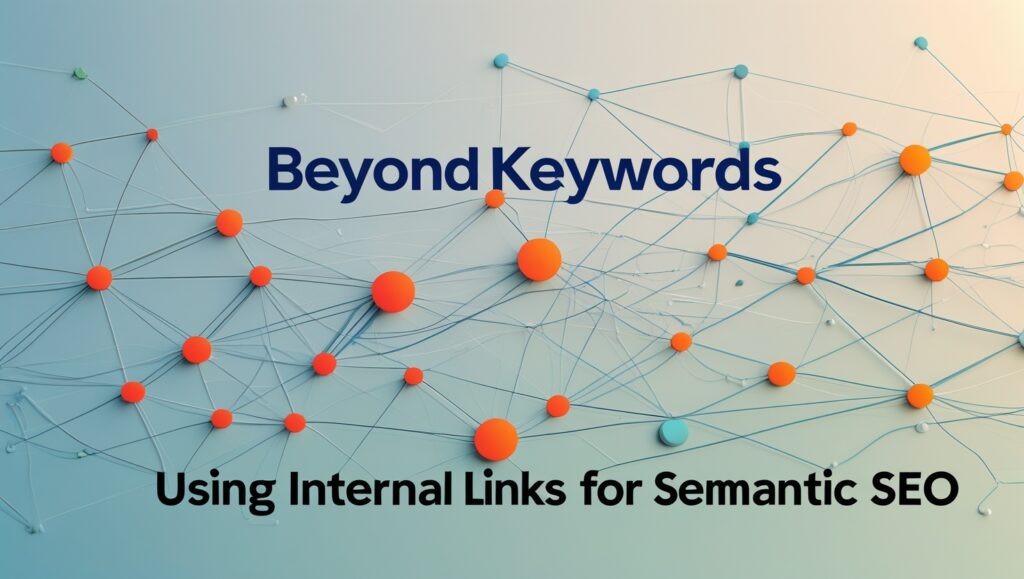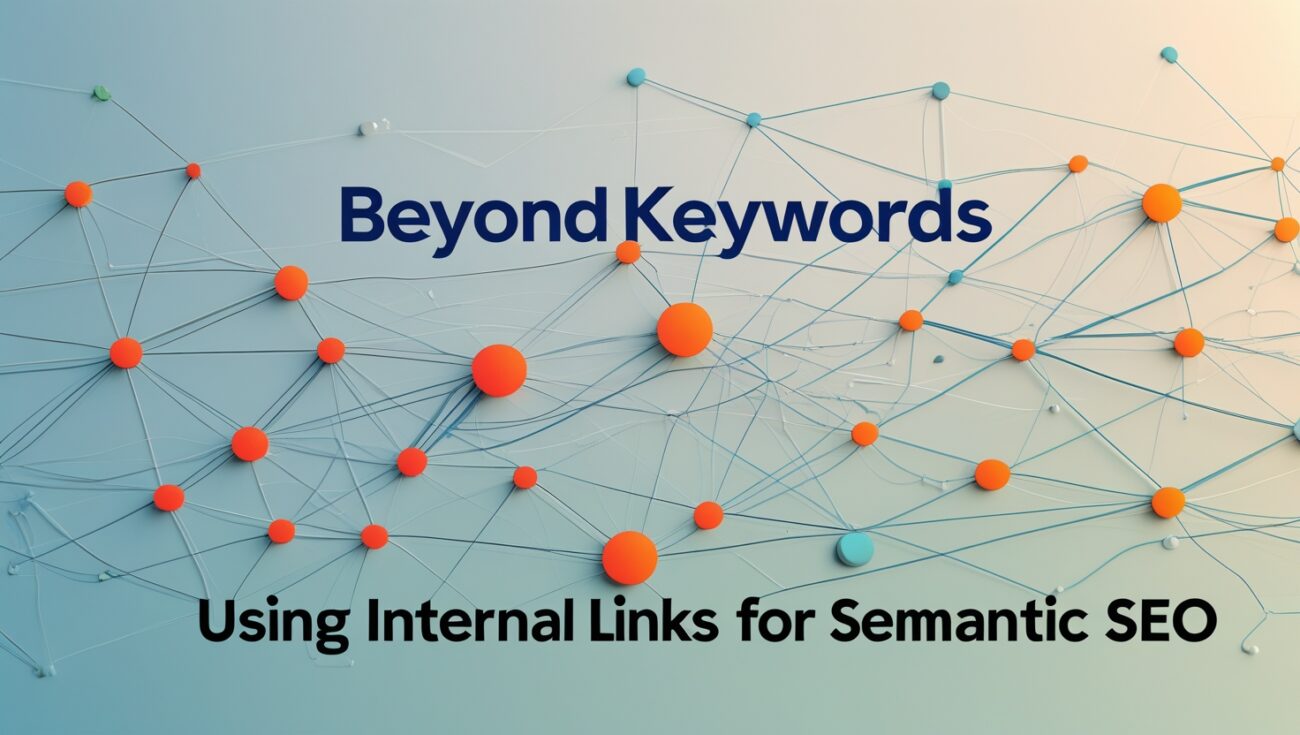Beyond Keywords: Using Internal Links for Semantic SEO
When I started in SEO, everything was about keywords. We’d find a keyword, create content for it, and then try to rank. But as Google’s algorithm has grown more sophisticated, I’ve seen a fundamental shift. It’s no longer just about the words on the page; it’s about the underlying meaning and relationships between those words. This is the world of Semantic SEO, and I’ve learned that mastering it is the key to achieving long-term authority and visibility.

Table of Contents
While many people think of Semantic SEO as a technical topic, I believe the most powerful tool for implementing it is a foundational one: internal linking. By intelligently connecting your content, you are literally building a web of topical relevance that search engines can easily understand and reward. Let me walk you through how to move beyond keywords and start using your internal links for deeper, more meaningful SEO results.
What is Semantic SEO? A Quick Breakdown
In its simplest form, Semantic SEO is the practice of creating content that helps search engines understand the meaning and context behind a topic, not just the words themselves. Google no longer just matches a search query to a keyword; it tries to understand the user’s intent and the full scope of a subject.
For example: If someone searches for “apple,” Google needs to know if they mean the fruit, the technology company, or the record label. A page about “apple pies” that also mentions “granny smith apples” and “cider” has strong semantic signals that tell Google the topic is about the fruit.
The Role of Internal Linking in Semantic SEO
Internal linking is the glue that binds your semantic relationships together. It is the most powerful way you can tell Google that a group of your pages are all related to a central topic.
- Building Topical Authority: By linking all of your related articles to a central “hub” or “pillar” page, you are effectively creating a detailed, comprehensive resource on a broad topic. For example, linking articles on “content marketing strategy,” “content promotion,” and “content calendars” to a pillar page on “The Ultimate Guide to Content Marketing” signals deep expertise.
- Distributing Relevance: Internal links don’t just pass link equity; they pass topical relevance. A link from a page discussing “hiking trails” to a page about “hiking boots” creates a semantic connection that helps both pages rank for related search queries.
- Reinforcing Entity Relationships: In the world of Semantic SEO, a person, place, or concept is called an “entity.” By consistently linking a specific entity (e.g., “The Google Panda Update”) to an authoritative page you’ve created on that topic, you are helping Google understand that you are a go-to expert on that specific entity.
Practical Strategies for Semantic Internal Linking
1. Embrace the Hub-and-Spoke Model
This is the quintessential semantic strategy. Plan your content around a central, comprehensive pillar page (the “hub”) and a series of supporting articles (the “spokes”). Then, use a reciprocal linking strategy where the hub links to every spoke, and every spoke links back to the hub. This creates a powerful, interconnected web that demonstrates true topical authority.
2. Use Varied and Contextual Anchor Text
Forget the old practice of using the same exact-match keyword over and over. For Semantic SEO, it’s best practice to use diverse and contextual anchor text. Use partial-match keywords, synonyms, and long-tail phrases to create natural-looking links that provide a richer semantic signal to Google. I use automated tools to find and implement varied anchor text, which is an otherwise impossible task to do manually.
3. Conduct a “Semantic Audit”
This is an advanced strategy that can yield huge results. Use a tool to analyze your content for semantically related keywords and topics that you have articles on. Then, look for pages that are related but aren’t currently linked. By connecting these orphaned pages, you’re building out your semantic web and unlocking their full ranking potential.
Why Automation is the Key to Unlocking Semantic SEO
Manually identifying all the complex semantic connections across your entire website is virtually impossible, especially as your site grows. Automated internal linking software can analyze your content for semantic relationships and provide you with a prioritized, actionable list of linking opportunities. This saves you countless hours and ensures you don’t miss crucial connections that will help you build topical authority. With Linkbot, you can automate this crucial part of your SEO.
Conclusion: Build a Website of Meaning
In the new world of SEO, the future is about meaning, not just keywords. By moving beyond a simple keyword strategy and adopting a semantic approach, you can create a website that is not only a trustworthy resource for your users but is also a clear authority in the eyes of search engines.
Internal linking is the primary tool for building this semantic web. By connecting your content in a meaningful way, you are creating a digital asset that will continue to rank higher and attract more traffic for years to come. Start building your website’s semantic foundation with Linkbot today.
Beyond the technical benefits, a strong semantic structure has a direct impact on the user experience. By guiding visitors from an informational article to a related, contextual page, you’re providing a seamless journey. This intuitive navigation helps potential customers find exactly what they’re looking for, which builds trust and contributes directly to the “Experience” component of your E-E-A-T score.
For a small business, a well-linked website also makes it more efficient for search engine crawlers. Your crawl budget is a limited resource, and a website with a logical semantic structure ensures that bots can easily discover all your important pages. This prevents your valuable content from being missed and helps it get indexed faster.
By linking your content to semantically related pages, you’re not just passing authority; you’re helping those pages rank for more than just their primary keyword. The context provided by your internal links can help a page attract traffic from a variety of long-tail keywords, leading to more qualified leads for your business.
For a busy business owner, simplicity is key. A clean, easy-to-understand site structure, supported by a smart semantic linking strategy, is far more effective than a messy, overcomplicated one. It reduces user confusion, improves bounce rates, and makes your website a more effective tool for attracting and converting customers.
The long-term, compounding effect of a consistent semantic linking strategy is what truly makes it a hero for a small business. Each new link you add that strengthens a topical relationship is an investment in your site’s future. Over time, these individual links build upon each other, creating a powerful network that will continue to drive organic traffic and boost your rankings for years to come.
I’ve found that semantic linking is a direct way to drive customer conversions. By linking from an informative blog post that solves a problem to a service page that offers a related solution, you’re creating a natural and helpful sales funnel. This is a far more effective way to nurture a lead than hoping they will randomly find your service page on their own.
A dedicated internal link audit, made simple with an automated tool, is also a powerful exercise in time management. Instead of wasting hours on a tedious task, you can quickly get a report that tells you exactly what semantic connections need to be fixed and where the best opportunities are. This allows you to spend your valuable time on core business activities.
One of the greatest benefits of using an automated tool for this is the “to-do” list it provides. Instead of being overwhelmed by a massive report, a good tool will give you an actionable list of semantically related links to create. It transforms a monumental SEO task into a series of manageable steps that you can tackle in minutes.
The long-term ROI of this specific SEO task is undeniable. It’s a foundational SEO tactic that you have full control over, and the benefits—from improved rankings and traffic to increased conversions—are long-lasting and continue to grow over time. The time invested in this strategy is paid back many times over.
I had a personal “Aha!” moment when I truly understood Semantic SEO. I had always been focused on the single keyword, but once I started to organize my content around entire topics and link them intentionally, I saw a dramatic increase in my rankings. It was the moment I realized that I wasn’t just building pages; I was building expertise.
It’s also important to understand the difference between a simple category page and a true semantic cluster. A category page simply groups articles, while a semantic cluster is a network of articles intentionally linked to a central pillar, demonstrating a deep level of expertise on the subject. The latter is a far more powerful strategy for boosting your authority.
Ultimately, semantic linking is not just an SEO tactic; it’s a fundamental part of building a high-quality, trustworthy website. By making a habit of linking thoughtfully and strategically, you’re building a digital asset that will work for you 24/7, helping you attract more customers and grow your business.

